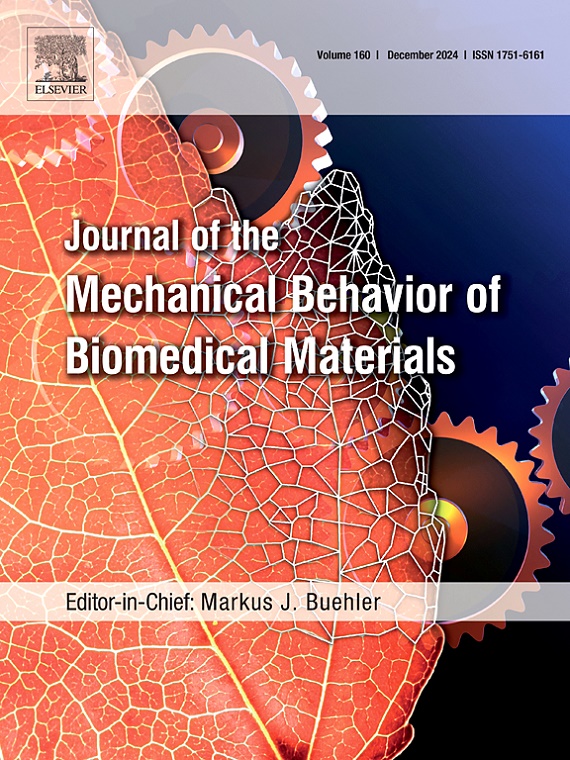Glass infiltration in an experimental ATZ ceramic composite reinforced with Al2O3 whiskers
IF 3.3
2区 医学
Q2 ENGINEERING, BIOMEDICAL
Journal of the Mechanical Behavior of Biomedical Materials
Pub Date : 2025-01-26
DOI:10.1016/j.jmbbm.2025.106892
引用次数: 0
Abstract
This study evaluated the development and characterization of alumina-toughened zirconia (ATZ) composites containing 10 wt% Al2O3 whiskers subjected to the glass infiltration. To obtain ATZ 90/10 composites, the commercial 3Y-TZP powder was mixed with synthesized alumina whiskers and subsequently compacted. Discs (n = 210) were pre-sintered at 1000 °C for 1 h. The infiltration of glass (68SiO2-11.7Al2O3-3CaO-7.3Na2O-10K2O) was developed by mixing glass and propylene glycol, which was then applied onto ATZ pre-sintered specimens. For infiltration, the graded discs were divided into two different sintering protocols: protocol 1 (1550 °C for 2 h) and protocol 2 (1350 °C for 1 h followed by 1550 °C for 2 h). As a control group, non-infiltrated specimens were sintered using protocol 1. The specimens were characterized by Scanning Electron Microscopy (SEM), X-ray diffraction (XRD), and Raman spectroscopy. Hardness, fracture toughness, and biaxial flexural strength tests followed by fractographic analysis were performed. Statistical analyses were conducted using Weibull distribution to calculate the material's modulus (m) and characteristic strength (95% CI), as well as ANOVA tests. High-aspect ratio alumina whiskers (10 μm × 200 nm) were synthesized. While the control group's XRD patterns evidenced only characteristic tetragonal zirconia and α−alumina peaks, the glass-infiltrated groups did not present characteristic peaks of crystalline materials. ATZ with alumina whiskers showed higher fracture toughness and characteristic strength compared to conventional ATZ. Furthermore, glass-infiltration improved the characteristic strength of conventional ATZ with no significant differences observed in the Weibull modulus. For W-G-2, C, and W groups the fractures originated at the zirconia surface, while for C-G-1-, C-G-2, and W-G-1 the origins were inside the ceramic microstructure. In conclusion, the development of ATZ with alumina whiskers increased the biaxial flexural strength and fracture toughness compared to conventional ATZ. The glass gradation significantly improved the characteristic strength of conventional ATZ regardless of the sintering protocol used, whereas it only improved the characteristic strength of whisker-reinforced ATZ when a single sintering was performed. Additionally, the sintering protocol influenced the thickness and amount of glass gradation in the composites.
求助全文
约1分钟内获得全文
求助全文
来源期刊

Journal of the Mechanical Behavior of Biomedical Materials
工程技术-材料科学:生物材料
CiteScore
7.20
自引率
7.70%
发文量
505
审稿时长
46 days
期刊介绍:
The Journal of the Mechanical Behavior of Biomedical Materials is concerned with the mechanical deformation, damage and failure under applied forces, of biological material (at the tissue, cellular and molecular levels) and of biomaterials, i.e. those materials which are designed to mimic or replace biological materials.
The primary focus of the journal is the synthesis of materials science, biology, and medical and dental science. Reports of fundamental scientific investigations are welcome, as are articles concerned with the practical application of materials in medical devices. Both experimental and theoretical work is of interest; theoretical papers will normally include comparison of predictions with experimental data, though we recognize that this may not always be appropriate. The journal also publishes technical notes concerned with emerging experimental or theoretical techniques, letters to the editor and, by invitation, review articles and papers describing existing techniques for the benefit of an interdisciplinary readership.
 求助内容:
求助内容: 应助结果提醒方式:
应助结果提醒方式:


